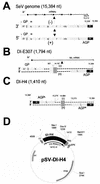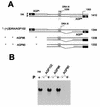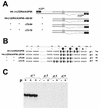The activity of Sendai virus genomic and antigenomic promoters requires a second element past the leader template regions: a motif (GNNNNN)3 is essential for replication
- PMID: 9525637
- PMCID: PMC109762
- DOI: 10.1128/JVI.72.4.3117-3128.1998
The activity of Sendai virus genomic and antigenomic promoters requires a second element past the leader template regions: a motif (GNNNNN)3 is essential for replication
Abstract
The paramyxovirus genome, a nonsegmented, negative-polarity, single-stranded RNA of approximately 15 kb, contains six transcription units flanked at the 3' and 5' ends by a short (approximately 50- to 60-nucleotide) extracistronic sequence, dubbed the positive and negative leader regions. These leader template regions, present at the 3' end of the genome and the antigenome, have been shown to contain essential signals governing RNA replication activity. Whether they are sufficient to promote replication is still open to question. By using a series of Sendai virus defective interfering RNAs carrying a nested set of deletions in the promoter regions, it is shown here that for both the genomic and antigenomic promoters, a 3'-end RNA sequence of 96 nucleotides is required to allow replication. Sequence comparison of active and inactive promoters led to the identification of a set of three nucleotide hexamers (nucleotides 79 to 84, 85 to 90, and 91 to 96) containing a repeated motif RXXYXX [shown as 5'-3' positive-strand]. Sequential mutation of each hexamer into its complementary sequence confirmed their essential role. The three hexamers are required, and their relative positioning is important, since displacing them by 6 nucleotides destroyed promoter function. RNAs carrying degenerate nucleotides in the three hexamers were used as replication templates. They led to the selection of actively replicating RNA species exclusively carrying the basic motif (GNNNNN)3 from nucleotides 79 to 96. These results clearly show that, apart from the region from nucleotides 1 to 31, previously identified as governing Sendai virus replication activity, a second element, spanning at the most nucleotides 79 to 96, appears essential. Thus, the paramyxovirus replication promoters are not confined to the leader template regions, as seems to be the case for the rhabdoviruses.
Figures










Similar articles
-
Precise mapping of the replication and transcription promoters of human parainfluenza virus type 3.Virology. 2000 Mar 30;269(1):201-11. doi: 10.1006/viro.2000.0223. Virology. 2000. PMID: 10725212
-
A functional antigenomic promoter for the paramyxovirus simian virus 5 requires proper spacing between an essential internal segment and the 3' terminus.J Virol. 1998 Jan;72(1):10-9. doi: 10.1128/JVI.72.1.10-19.1998. J Virol. 1998. PMID: 9420195 Free PMC article.
-
RNA replication for the paramyxovirus simian virus 5 requires an internal repeated (CGNNNN) sequence motif.J Virol. 1999 Jan;73(1):805-9. doi: 10.1128/JVI.73.1.805-809.1999. J Virol. 1999. PMID: 9847393 Free PMC article.
-
Paramyxovirus RNA synthesis, mRNA editing, and genome hexamer phase: A review.Virology. 2016 Nov;498:94-98. doi: 10.1016/j.virol.2016.08.018. Epub 2016 Aug 25. Virology. 2016. PMID: 27567257 Review.
-
A new model for coronavirus transcription.Adv Exp Med Biol. 1998;440:215-9. doi: 10.1007/978-1-4615-5331-1_26. Adv Exp Med Biol. 1998. PMID: 9782283 Review.
Cited by
-
Initiation and regulation of paramyxovirus transcription and replication.Virology. 2015 May;479-480:545-54. doi: 10.1016/j.virol.2015.01.014. Epub 2015 Feb 13. Virology. 2015. PMID: 25683441 Free PMC article. Review.
-
Completion of the sequence of a cetacean morbillivirus and comparative analysis of the complete genome sequences of four morbilliviruses.Virus Genes. 2005 Jan;30(1):113-9. doi: 10.1007/s11262-004-4588-7. Virus Genes. 2005. PMID: 15744569
-
Identification and characterization of short leader and trailer RNAs synthesized by the Ebola virus RNA polymerase.PLoS Pathog. 2021 Oct 26;17(10):e1010002. doi: 10.1371/journal.ppat.1010002. eCollection 2021 Oct. PLoS Pathog. 2021. PMID: 34699554 Free PMC article.
-
Virus promoters determine interference by defective RNAs: selective amplification of mini-RNA vectors and rescue from cDNA by a 3' copy-back ambisense rabies virus.J Virol. 1999 May;73(5):3818-25. doi: 10.1128/JVI.73.5.3818-3825.1999. J Virol. 1999. PMID: 10196276 Free PMC article.
-
Nucleocapsid incorporation into parainfluenza virus is regulated by specific interaction with matrix protein.J Virol. 2001 Feb;75(3):1117-23. doi: 10.1128/JVI.75.3.1117-1123.2001. J Virol. 2001. PMID: 11152484 Free PMC article.
References
-
- Blumberg B M, Chan J, Udem S A. Function of paramyxovirus 3′ and 5′ end sequences in theory and practice. In: Kingsbury D W, editor. The paramyxoviruses. New York, N.Y: Plenum Publishing Corp.; 1991. pp. 235–247.
-
- Blumberg B M, Giorgi C, Kolakofsky D. N protein of vesicular stomatitis virus selectively encapsidates leader RNA in vitro. Cell. 1983;32:559–567. - PubMed
-
- Blumberg B M, Leppert M, Kolakofsky D. Interaction of VSV leader RNA and nucleocapsid protein may control VSV genome replication. Cell. 1981;23:837–845. - PubMed
-
- Calain P, Curran J, Kolakofsky D, Roux L. Molecular cloning of natural paramyxovirus copy-back defective interfering RNAs and their expression from DNA. Virology. 1992;191:62–71. - PubMed
Publication types
MeSH terms
Substances
LinkOut - more resources
Full Text Sources
Other Literature Sources
Miscellaneous

